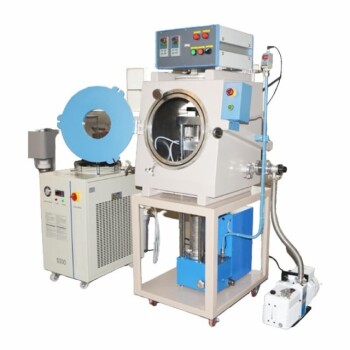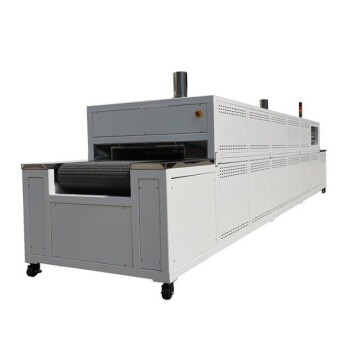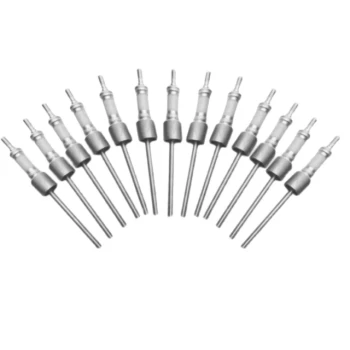The core component of an induction heater is the work coil, a custom-formed inductor that creates the heating effect. This coil is most commonly made from highly conductive copper tubing, which allows for both electrical current and a liquid coolant (typically water) to flow through it.
The work coil is the heart of the system, but its power is unlocked by a surrounding circuit that generates a high-frequency alternating current. Understanding this relationship is key to grasping how induction heating achieves its remarkable efficiency and control.
How the Coil Enables Induction Heating
Induction heating is a non-contact process. The coil does not get hot and touch the part; rather, it creates an energy field that causes the part to heat itself from within.
Creating the Magnetic Field
A high-frequency alternating current (AC) is passed through the copper coil. According to Ampere's Law, this flow of electricity generates an intense and rapidly alternating magnetic field in the space within and around the coil.
Inducing Eddy Currents
When a conductive workpiece (like a piece of steel) is placed within this magnetic field, the field induces circular electrical currents inside the material. These are known as eddy currents.
The Source of Heat
These eddy currents are not without opposition. The workpiece's own internal electrical resistance fights against the flow of these currents. This opposition generates immense friction and, consequently, intense and rapid heat, a principle known as Joule heating.
The Anatomy of a Full Induction System
While the coil is the most visible component, it is part of a larger, precisely engineered system. Each part plays a critical role in delivering controlled energy.
The Power Supply
This is the source of the energy. It converts standard AC line voltage into the high-frequency, high-power AC required to drive the work coil effectively.
The Resonant Tank Circuit
The work coil is almost always paired with capacitors. Together, they form a resonant tank circuit. This circuit acts like a flywheel for electrical energy, dramatically increasing the efficiency of the power transfer from the supply to the workpiece.
The Driver and Control Circuit
This is the brain of the operation. Modern induction heaters use sophisticated control circuits, often featuring Insulated-Gate Bipolar Transistors (IGBTs), to regulate the power output and frequency. Feedback from sensors like thermocouples allows the circuit to maintain precise temperatures.
Understanding the Key Trade-offs
The design of an induction system is not one-size-fits-all. It involves critical engineering trade-offs based on the specific heating task.
Coil Geometry is Paramount
The shape, size, and number of turns in the coil dictate the pattern and intensity of the magnetic field. The coil must be carefully designed to "couple" efficiently with the workpiece, ensuring the magnetic field is concentrated only where heat is needed.
Frequency Determines Heat Depth
The frequency of the alternating current is a crucial variable. Higher frequencies tend to heat only the surface of a part, which is ideal for case hardening. Lower frequencies penetrate deeper into the material, which is necessary for applications like forging or melting.
Workpiece Material Matters
The effectiveness of induction heating depends heavily on the electrical resistivity and magnetic properties of the target material. Highly conductive materials like copper are harder to heat than less conductive materials like steel because they offer less resistance to the eddy currents.
Making the Right Choice for Your Goal
The optimal induction setup is always dictated by the desired outcome. Understanding the core components allows you to specify the right system for your industrial process.
- If your primary focus is surface hardening: You require a high-frequency power supply paired with a coil that is tightly coupled to the workpiece's geometry.
- If your primary focus is through-heating for forging: You need a lower-frequency system that allows the magnetic field to penetrate deep into the material's core.
- If your primary focus is high-precision brazing or soldering: You need a system with an advanced control circuit and a specialized coil designed for localized heating.
Ultimately, mastering induction heating comes from seeing it not as a single component, but as an integrated system where every part contributes to the final result.
Summary Table:
| Component | Material/Description | Key Function |
|---|---|---|
| Work Coil | Copper tubing | Generates magnetic field for heating |
| Power Supply | Electronic components | Converts AC to high-frequency power |
| Resonant Tank Circuit | Coil and capacitors | Enhances energy transfer efficiency |
| Control Circuit | IGBTs, sensors | Regulates power and temperature |
Ready to optimize your industrial heating process? KINTEK leverages exceptional R&D and in-house manufacturing to provide advanced high-temperature furnace solutions, including induction heaters tailored for diverse laboratory needs. Our product line—featuring Muffle, Tube, Rotary Furnaces, Vacuum & Atmosphere Furnaces, and CVD/PECVD Systems—is enhanced by strong deep customization capabilities to precisely meet your unique experimental requirements. Contact us today to discuss how our expertise can boost your efficiency and precision!
Related Products
- Silicon Carbide SiC Thermal Heating Elements for Electric Furnace
- Molybdenum Disilicide MoSi2 Thermal Heating Elements for Electric Furnace
- Small Vacuum Heat Treat and Tungsten Wire Sintering Furnace
- Vacuum Hot Press Furnace Machine for Lamination and Heating
- Mesh Belt Controlled Atmosphere Furnace Inert Nitrogen Atmosphere Furnace
People Also Ask
- What parameters does the IEC standard specify for heating elements? Ensure Safety and Performance
- What is the operating temperature of SiC? Unlock Reliable Performance Up to 1600°C
- What temperature ranges are recommended for SiC versus MoSi2 heating elements? Optimize Your Furnace Performance
- What are the advantages of silicon carbide heating elements in dental furnaces? Boost Zirconia Sintering Quality
- What is silicon carbide used for in heating applications? Discover Its High-Temperature Durability










